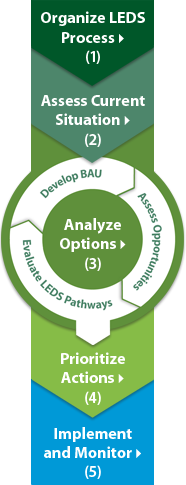The Asia LEDS Partnership is a voluntary regional network comprised of individuals and organizations from the public, private, and non-governmental sectors active in designing, promoting, and/or implementing Low Emission Development Strategies (LEDS) in the Asia- Pacific region.
The Asia LEDS Partnership consists of 1273 numbers (421 organizations and 852 individuals). The membership includes 65 Government Ministries/Agencies from 15 Asian countries (Nepal, Malaysia, Vietnam, Thailand, Indonesia, Cambodia, Republic of Korea, Myanmar, Mongolia, Pakistan, Philippines, Bangladesh, Bhutan, Sri Lanka, Laos PDR).
The Asia LEDS Partnership’s goal is to advance the development of country-led and country-specific strategic plans to promote economic growth while reducing GHG emissions—without causing trade-offs to other environmental pressures—in the Asia region.
ICLEI – Local Governments for Sustainability serves as the Secretariat.
The geographic focus of the Asia LEDS Partnership includes countries within the sub-regions of East Asia, Southeast Asia, South Asia, Central Asia, and the Pacific (including Australia and New Zealand). Members of the Asia LEDS Partnership comprise individuals and organizations working within the public, private, and non-governmental sectors to advance low emission development in Asia. This includes members from both developing and developed countries as well as international partners supporting LEDS in Asia from any region around the world.

Low emission development strategies (LEDS) are country-led and country-specific strategic plans to promote economic growth while simultaneously reducing greenhouse gas (GHG) emissions (in absolute and/or relative terms) over the long term. LEDS carries the same meaning as low carbon development strategies, low emission climate-resilient development strategies, and provides a framework to support broader green growth strategies. While LEDS focus on reducing GHG emissions, due diligence should be taken to ensure that LEDS do not cause unintended environmental pressures.
At the country level, LEDS are a key element for short, medium, and long-term national economic development plans, contributing to green growth, green economy, and climate resiliency. At the regional and global level, LEDS support the objectives of the Sustainable Development Goals, prioritizing the four “pros” of pro-growth, pro-job, pro-poor, and pro-environment.
The LEDS process is defined by five stages, including (1) organizing the process (e.g., identifying the institutional structure, selecting mechanisms for stakeholder involvement); (2) collecting data and assessing the current situation; (3) using analytical decision-making to identify and assess pathways; (4) prioritizing and planning a portfolio of actions; and (5) implementing and monitoring actions.